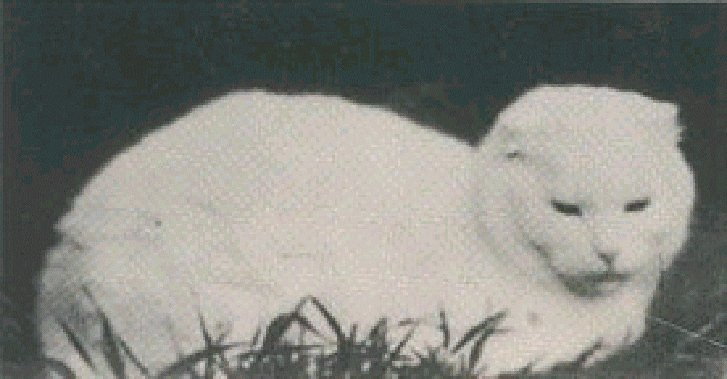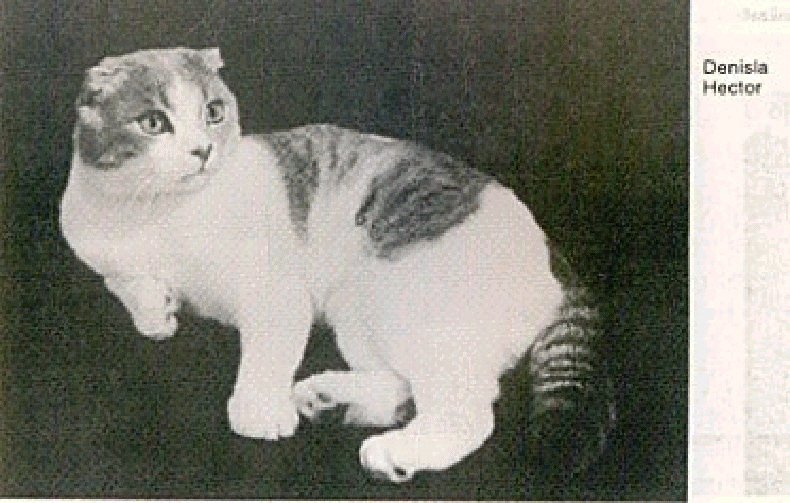|
(Please be patient, this page takes a while to load)

The following story and photographs are from the book entitled
The Scottish Fold 1961 - 1991 ©, edited by Louise Becker*.
We would like to thank Louise, Karen Votava, and Salle Wolfe Peters
for their contributions not only to the book, but to the wonderful
world of Scottish Folds.

The Scottish Fold's inception and early history can be traced
back to events that occurred in the 1960s.
The story began in 1961, at Coupar Angus, in the Tayside region
of Scotland, Northwest of Dundee. William Ross, a shepherd, returning
from his day's work, passed by the neighboring McRae's farm and noticed
a white cat playing in the front yard. Its ears were folded forward
and downward.
Knowing his wife, Mary, had an interest in cats, William told
her what he had seen. Mary, very intrigued, decided to ask the McRaes
about the cat.

The cat's name was Susie and her parents were barn cats. Her
mother was killed in a farm accident. No one knew about the father.
There was another folded ear male in Susie's litter; but, he had disappeared.

Susie
The Rosses were promised a folded ear kitten from Susie's next
litter. Two years later, in 1963, they received a white folded ear female.
They named the kitten Snooks, who became the beginning lineage of the
Scottish Fold.

Mary and Snooks
Snooks was first bred to an unknown red tabby male. In the
litter, only one male kitten had folded ears. This white male, named
Snowball, was later mated with Lady May, a white British Shorthair.
Five folded ear kittens were produced.
Snooks was next bred to Ryelands Regal Gent, a blue British
Shorthair. In 1969, two folded ear kittens were born in this second
litter - Denisla Hester and Denisla Hector, which, along with Snowball
and Lady May's kittens, became the foundation for the future.

Denisla Hector
Securing the help of English geneticists to start a breeding
program, and using farm cats and British Shorthairs, the Rosses produced
several kittens. These first folded ear cats were known as "lops", after
the lop-eared rabbits. By 1966, there were renamed "Scottish Folds".
The breed was accepted by the Governing Council of the Cat
Fancy in England; but, in 1971, registration was closed. The reasoning
given was that it was too difficult to keep Folds free of ear mite infestation
(which was later proven false), and because several blue-eyed white
cats that were used in breeding produced too many kittens that were
born deaf.
The Scottish Fold was bred in Europe for over 10 years with
one goal in mind - to preserve a rare mutation. Several other breeders
became involved with the breed.
In 1970, Dr. Neil Todd, a New England Geneticist, brought three
of Snook's daughters to America for study. Dr. Todd soon lost interest
in the Fold research and found home for the Folds. One (Hector) went
to Lynn Lamoreux, and later to Salle Wolfe Peters.
Salle, a well-known Manx breeder, became the first "breeder"
in the United States to work with the Scottish Folds.
In August 1972, Briony Sivewright, from Scotland, and her husband
were transferred to Hill AFB in Utah. She received a blue cream and
white Fold, which she showed to Ann Kimball and Karen Votava. The cat
was bred to one of Ann's American Shorthairs and produced three folded
ear kittens. One remained with Ann, another went to Karen Votava, and
the third went to Salle.
The rest is history
..
*Written permission to use the above was obtained from Mrs. Becker
per the copyright instructions and is on file. All photos have been
registered and are protected by Digimarc
©.
|